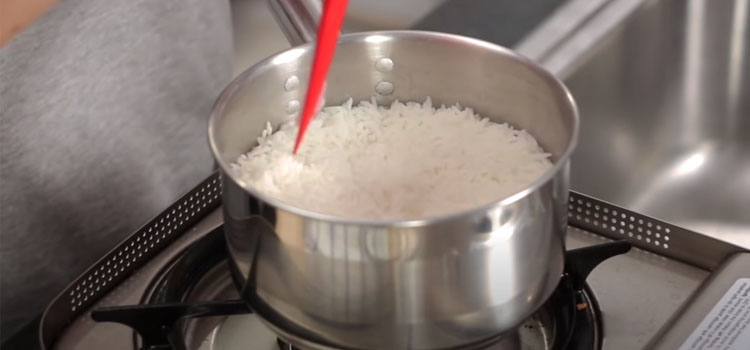Last Updated on September 15, 2024 by Shari Mason
Cooked rice is an absolute must-have in my kitchen, but keeping it moist after reheating can be tough. It’s a real letdown to look forward to a bowl of rice, only to find it’s become dry and tough.
Over the years, I’ve discovered that the secret to preventing this lies in storing and reheating the rice.
So how do you keep cooked rice from drying out?
Trust me, a few simple tricks can make all the difference in your rice experience.
10 Tips On How To Keep Cooked Rice From Drying Out


- Immediate Airtight Storage: Transfer freshly cooked rice [1] into an airtight container while still warm. This prevents moisture from escaping quickly, maintaining its plumpness and moisture content.
- Use a Damp Cloth or Paper Towel: Place a damp cloth or a moistened paper towel on the rice before sealing the container. This creates a barrier against evaporation, helping the rice retain its moisture.
- Refrigeration: If not consuming the rice immediately, refrigerate it within two hours of cooking. Cold temperatures slow down moisture loss, preserving the rice’s texture and flavor.
- Avoid Overcooking: Cook the rice just until it’s tender. Even with proper storage, overcooked rice is more prone to dry and clumpy.
- Splash of Water When Reheating: Add a splash of water to the rice before reheating in the microwave or on the stovetop. This reintroduces steam and prevents the rice from becoming parched during reheating.
- Steam Reheating: Reheat the rice using the steam method – place it in a heatproof container over a pot of simmering water. This method gently reheats the rice without stripping away moisture.
- Use Broth or Sauce: When reheating, add a bit of broth, sauce, or even a drizzle of water to the rice. This not only imparts flavor but also contributes to keeping the rice moist.
- Microwave Covering: When reheating, cover the rice with a microwave-safe lid or wrap it to trap steam and prevent moisture loss.
- Frequent Stirring: If you’re reheating rice in a pan, gently stir it occasionally. This redistributes moisture and ensures even reheating.
- Portion Control: Store rice in smaller portions if you’re preparing rice for multiple meals. This way, you only need to reheat what you’ll consume, minimizing the risk of drying out leftovers.
Also Read:
- How To Dry Rice For Fried Rice?
- How To Fix Undercooked Rice?
- How Long Can You Keep Rice In A Rice Cooker?
Why Does Cooked Rice Dry Out?
Cooked rice tends to dry out due to the natural process of moisture evaporation [2]. Once the rice is cooked and exposed to air, the moisture within its grains begins to escape into the surrounding environment.
This gradual evaporation causes the rice to lose its plumpness and succulence, resulting in a drier and less appealing texture.
“We came from nothing. One house. Ten people. Even on days the lights were off. The worst day was not eating. Surviving off rice and toast.”
– Lil Durk, American Rapper
Air circulation, temperature, and time contribute to how moisture evaporates from cooked rice, underscoring the importance of effective storage methods to preserve its moisture content.
What’s The Key To Immediate Storage?


- Warm Transfer: Transfer the cooked rice into an airtight container while it’s still warm from cooking. This quick transition minimizes moisture loss during the crucial initial stages.
- Airtight Seal: Ensure the container has a secure and airtight seal. This prevents excess moisture from escaping and maintains the rice’s natural moisture content.
- Avoid Delay: Don’t let the rice sit at room temperature for an extended period before transferring it to the container. Prompt storage reduces the time it’s exposed to air, preserving moisture.
How Does Refrigeration Play a Role?
Refrigeration plays a crucial role in maintaining the moisture of cooked rice. Once rice is cooked, it’s important to refrigerate it within two hours to prevent the growth of harmful bacteria.
“Unlocking the secret to keeping cooked rice moist is akin to preserving a treasure of flavor. With a dash of know-how and a touch of moisture magic, you’re not just cooking rice – crafting a symphony of taste and texture that’s both satisfying and sublime.”
– Eat Pallet Restaurant & Food Advice
Cold temperatures slow down the process of moisture evaporation, ensuring that the rice retains its plumpness and texture.
By promptly refrigerating cooked rice, you create an environment that extends its shelf life while safeguarding its moisture content, resulting in rice that remains enjoyable and delectably moist when reheated.
FAQs
u003cstrongu003eCan I reheat rice without drying it out?u003c/strongu003e
Yes, you can reheat rice without drying it out. A simple trick is to add a splash of water before reheating. u003cbru003eu003cbru003eWhether you’re using a microwave or stovetop, the water creates steam as it heats up, infusing the rice with moisture and preventing it from becoming parched. u003cbru003eu003cbru003eThis technique ensures that your reheated rice maintains its original texture and juiciness, resulting in a satisfying and enjoyable meal every time.
u003cstrongu003eHow do you moisten leftover rice?u003c/strongu003e
To moisten leftover rice, sprinkle a few drops of water, cover it with a lid or wrap, and heat it in short intervals in the microwave, checking and stirring until the desired moisture level is reached.
Final Thoughts
Keeping it moist is like a kitchen secret regarding cooked rice.
You’re preserving its goodness by putting warm rice in a tight container right after cooking, using a damp cloth, and keeping it cold in the fridge.
When you reheat, a splash of water helps, making it tasty again. These tricks ensure your rice stays juicy and delicious, making your meals enjoyable.
References:
- https://www.webmd.com/first-aid/rice-method-injuries
- https://www.nationalgeographic.org/encyclopedia/evaporation/
- Can You Put an AC Unit in the Kitchen? - September 27, 2024
- What Cheese Does Olive Garden Use? Discover Their Signature - September 27, 2024
- How to Cancel a Pizza Hut Order? Quick & Easy Guide - September 24, 2024


